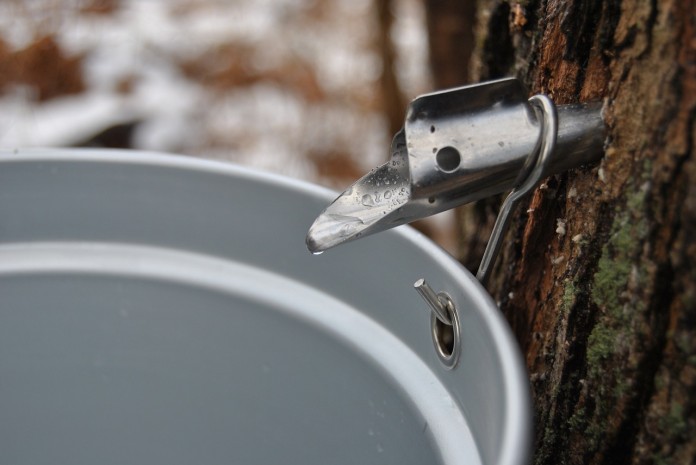As a boy, one of the family’s pastimes was the dreaded “Sunday Drive.” It was a year-round occurrence that could be boring beyond a 10-year-old’s tolerance, but, sometimes, an unexpected event would tack imaginary photos on my mind’s memory board.
Now, those snapshots can be triggered by visiting parks, stream banks or watching an airplane take off. I find myself mysteriously teleported to another time — camping at Guilford Lake State Park, walking the paths of Schoenbrunn Village, peering through binoculars at Pittsburgh Airport or watching a bobber drift on Little Beaver Creek. Sometimes the haunting is so powerful that I expect a reincarnation to have occurred. I sometimes even smell the Old Spice my father favored after his Sunday morning shave.
It happened again last weekend, but it wasn’t unexpected and it wasn’t just a single memory to flood my thoughts. It was a lifetime-revealing scrapbook. The smell of boiling maple sap transported me to my Uncle Harry and Aunt Nellie’s home. There was my dad and his brother Luther sipping homemade wine as they watched the pans bubble. My brother and I were hungrily eating hotdogs that had been boiled in “center-pan” syrup on a Coleman cookstove while we swigged Orange Crush.
It was late Saturday afternoon, and I’d driven to an old friend’s farm near Sycamore, Ohio. Gary Shellhouse and his extended family — his family includes close friends made over his lifetime — had spent the last few weeks gathering 2,758 gallons of maple sap which they had stored in repurposed dairy holding tanks. The gathering was finished and the boiling process had begun at 4 p.m. on Friday and would last late into Sunday evening.
As I got out of my truck, the combination of campfire woodsmoke, the controlled boiling of the sap, and the sweet drift of cooking maple syrup proved to be a genuine time machine.
Shifts of 24-hour watchers were easy to find as they huddled around the pans cracking jokes and sipping cold drinks. There was also plenty of sharable food and beverages hauled back into the woodland sugar camp. Kids of all ages played around the campfire as the sugarmakers and their spouses laughed as they reminisced, talked about children and grandchildren, the latest family events and home remodeling projects. Rusty, a gray-muzzled yellow lab, carried a stick and played keep-away from anyone reaching to toss it.
The sugar camp sits just a few yards from the one first established in 1930 when World War I veteran Roy Shellhouse and his wife Hattie purchased the farm. The old sugar-shack was abandoned in 1946.
Thirty years later, Roy’s boy Harold and grandson, 12-year-old Donny, built a little log cabin near the site. That year, with Hattie overseeing the process, enough sap was gathered to make one gallon of syrup for the family to share.
While the cabin still exists, it’s surrounded by a boiling shed, storage building, a proper cabin with wood cookstove, an outhouse and enough generator power to brighten the area during the night.
Since that time, five generations of family and friends have gathered in the woodlot to help or just share stories during the annual boil. Still using a three-pan system to cook down the sap rather than an evaporator, it’s a little more time-consuming.
Gary, who now leads the work, believes that the syrup tastes better to him by doing it the “old way.” I’m not sure that it’s the process that adds the homey flavor — but rather the hearts of those attending that lend the flavorful essence. Gary’s nephew Chad added a little more science this year, installing a home-built reverse osmosis system. It removed much of the water before cooking, helping to shorten the boiling time.
According to Gary, it takes about 40 gallons of maple sap to create one gallon of maple syrup. Using that formula, he expects they’ll fill an assortment of Ball jars with 70-80 gallons of 100% pure maple syrup.
How does it compare to the Log Cabin, Mrs. Butterworth or Aunt Jemima you might have on your shelf? It doesn’t compare at all. Most branded pancake syrups that many believe are derived from maple trees come from corn fields. Most brands don’t use any derivative of maple syrup in their products at all. Those that do only include a paltry 2-4%.
If I’ve whetted your appetite for genuine maple syrup, you can find it at better grocery and farm produce stores. Just don’t expect to find any bearing the Shellhouse name — not a drop of it is ever sold.
The reason they pull sap was never to make money but to build those invaluable memories with family and friends. All that syrup will be divided up between those who help or will be gifted during holidays, an occasional thank you or just for the sake of giving. Their maple syrup is just too valuable to sell.
I’ve had the pleasure of attending many of those boiling days, even that first one in 1976. During the intervening 47 years, many of those once laughing around the pans are gone, replaced by their own children, grandchildren and even great-grandchildren. Though changes may come, it will always be family and friends that make this batch of syrup so incredibly good.
As the evening grew deep, the hypnotic draw of the mist above that boiling sap and the curling drift over the campfire began to play tricks on me. I imagined I spotted once familiar faces laughing, smiling and sharing their own silent stories.
Walking back to my truck, I knew my dad would have enjoyed this crew of sugarmakers. As that thought passed, I swear I caught the drifting scent of Old Spice on the night’s breeze.
“Some people go to priests, others to poetry. I go to my friends.”
— Virginia Woolf













